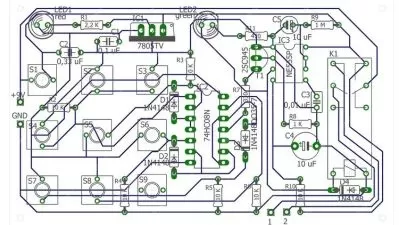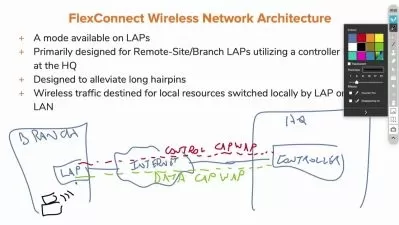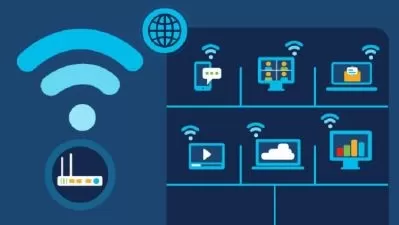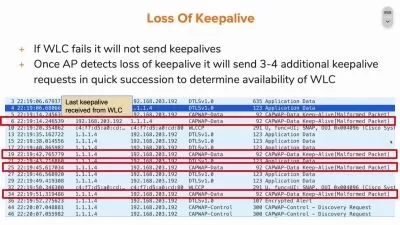Wireless Digital Communications and Signal Processing
Benny Bing
4:38:20
Description
Modulation, coding, pulse shaping, signal estimation, channel modeling, multicarrier and multiantenna transmission
What You'll Learn?
- Understand the fundamental principles of wireless signal transmission and processing
- Evaluate modulation and coding schemes for a given application, and compare the error performance of different modulations
- Apply channel models and pulse shaping in wireless systems
- Learn equalization techniques, matched filtering, and spectral estimation
- Review multicarrier transmission, analyze subcarrier power loading, and evaluate the impact of frequency offset
- Design and optimize digital beamforming and multiple antenna systems
- Direct Sampling, Power Amplifier Linearization, N-Path Filtering, Phase-Locked Loop
Who is this for?
What You Need to Know?
More details
DescriptionWireless networks have expanded beyond person-to-person communications, connecting not only users but also machines, devices, and objects. Using 420 illustrative slides, this course will cover the fundamental principles of digital communications and describe the role of digital signal processing in driving wireless technologies. Participants will learn how to analyze the performance of digital modulation techniques such as quadrature amplitude modulation (QAM) and apply them in modern wireless systems. High-order modulation (such as 256-QAM, 1024-QAM) achieves greater spectral efficiency, thus leading to higher data rates. They form the basis of current and emerging wireless standards (such as 5G and Wi-Fi). By changing the modulation and coding, the available data rate and robustness of the wireless signal can be adapted to deployment conditions.
The Nyquist Theorem allows bandlimited continuous-time signals to be represented by their discrete-time samples. Consequently, a wireless communications system, including channel impairments like multipath fading and noise, can be analyzed in terms of their discrete-time equivalents. Linear time-invariant systems, which are characterized by convolution with an impulse response, can be used to model wireless channels. Deconvolution can be used to equalize the effects of the channel. Upsampling, downsampling, and multirate signal processing allow efficient implementation of pulse shaping at the transmitter and matched filtering at the receiver. This course will present many DSP tools that are relevant to wireless system design, analysis, and optimization, including practical techniques related to multiple antenna signal processing (transmit beamforming, spatial multiplexing, and space-time coding).
Who this course is for:
- Anyone who wish to gain a deeper understanding of wireless communications
- Wireless signal processing engineers working on physical layer (PHY) algorithm design and optimization
Wireless networks have expanded beyond person-to-person communications, connecting not only users but also machines, devices, and objects. Using 420 illustrative slides, this course will cover the fundamental principles of digital communications and describe the role of digital signal processing in driving wireless technologies. Participants will learn how to analyze the performance of digital modulation techniques such as quadrature amplitude modulation (QAM) and apply them in modern wireless systems. High-order modulation (such as 256-QAM, 1024-QAM) achieves greater spectral efficiency, thus leading to higher data rates. They form the basis of current and emerging wireless standards (such as 5G and Wi-Fi). By changing the modulation and coding, the available data rate and robustness of the wireless signal can be adapted to deployment conditions.
The Nyquist Theorem allows bandlimited continuous-time signals to be represented by their discrete-time samples. Consequently, a wireless communications system, including channel impairments like multipath fading and noise, can be analyzed in terms of their discrete-time equivalents. Linear time-invariant systems, which are characterized by convolution with an impulse response, can be used to model wireless channels. Deconvolution can be used to equalize the effects of the channel. Upsampling, downsampling, and multirate signal processing allow efficient implementation of pulse shaping at the transmitter and matched filtering at the receiver. This course will present many DSP tools that are relevant to wireless system design, analysis, and optimization, including practical techniques related to multiple antenna signal processing (transmit beamforming, spatial multiplexing, and space-time coding).
Who this course is for:
- Anyone who wish to gain a deeper understanding of wireless communications
- Wireless signal processing engineers working on physical layer (PHY) algorithm design and optimization
User Reviews
Rating
Benny Bing
Instructor's Courses
Udemy
View courses Udemy- language english
- Training sessions 16
- duration 4:38:20
- Release Date 2024/04/23














